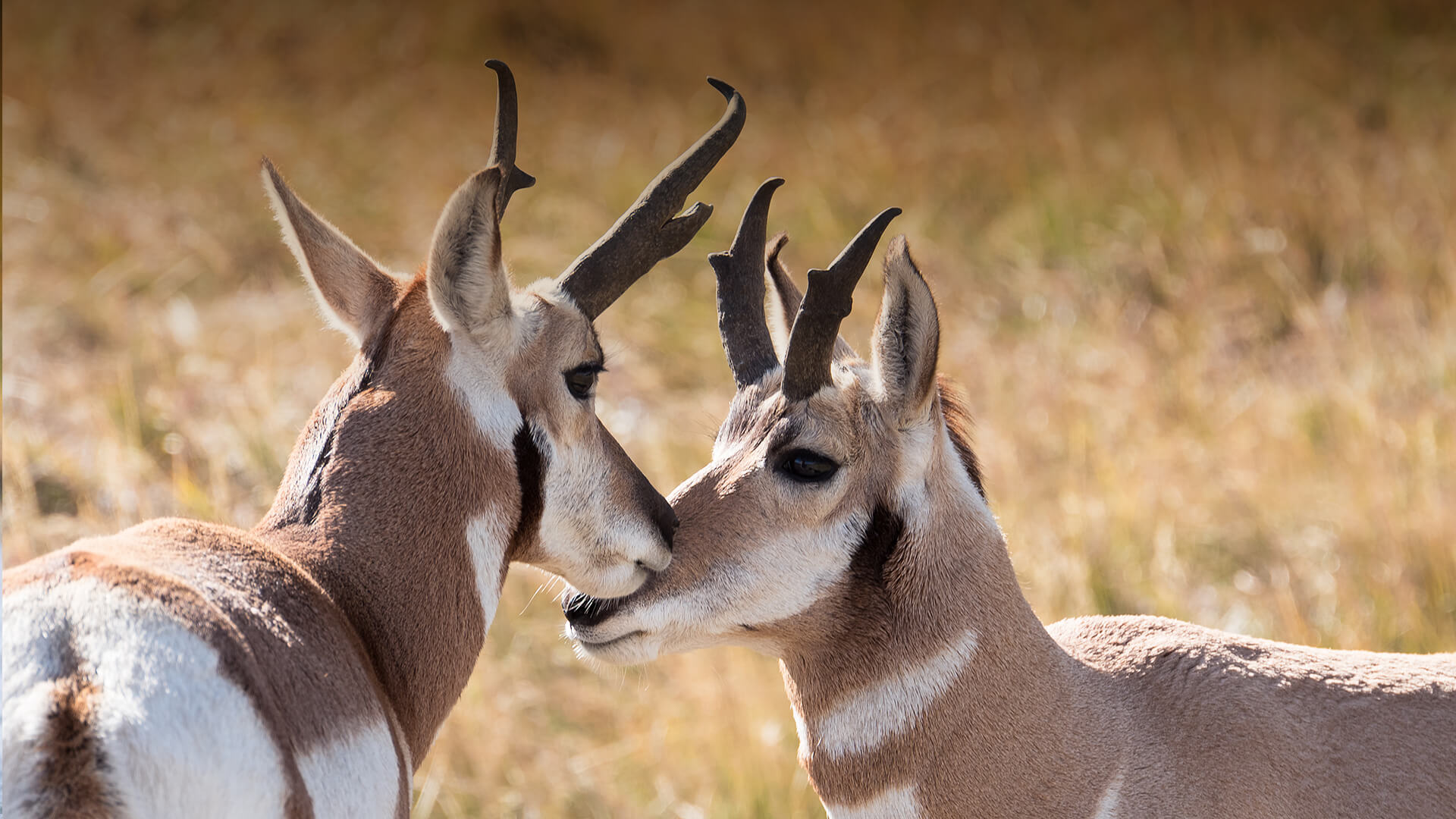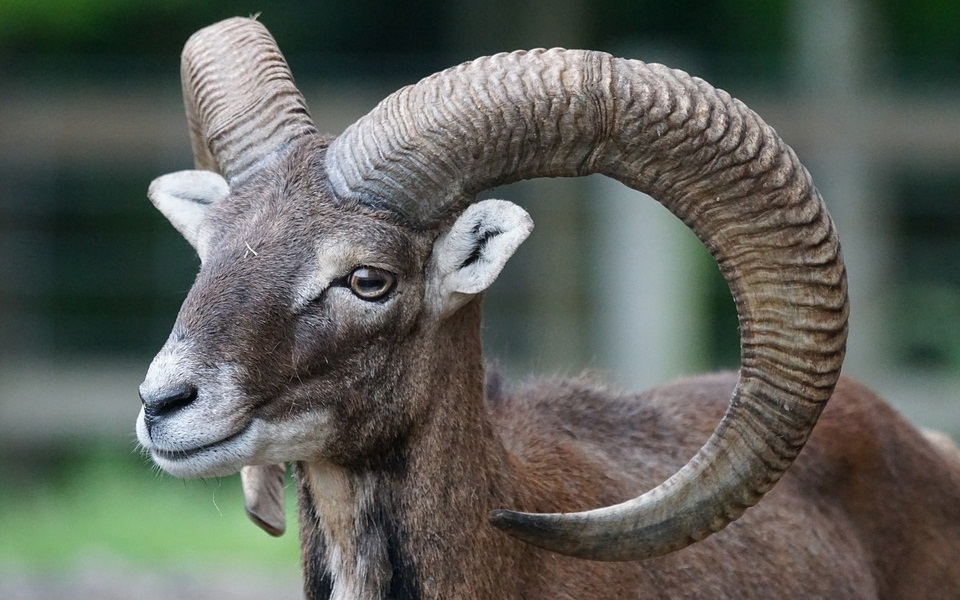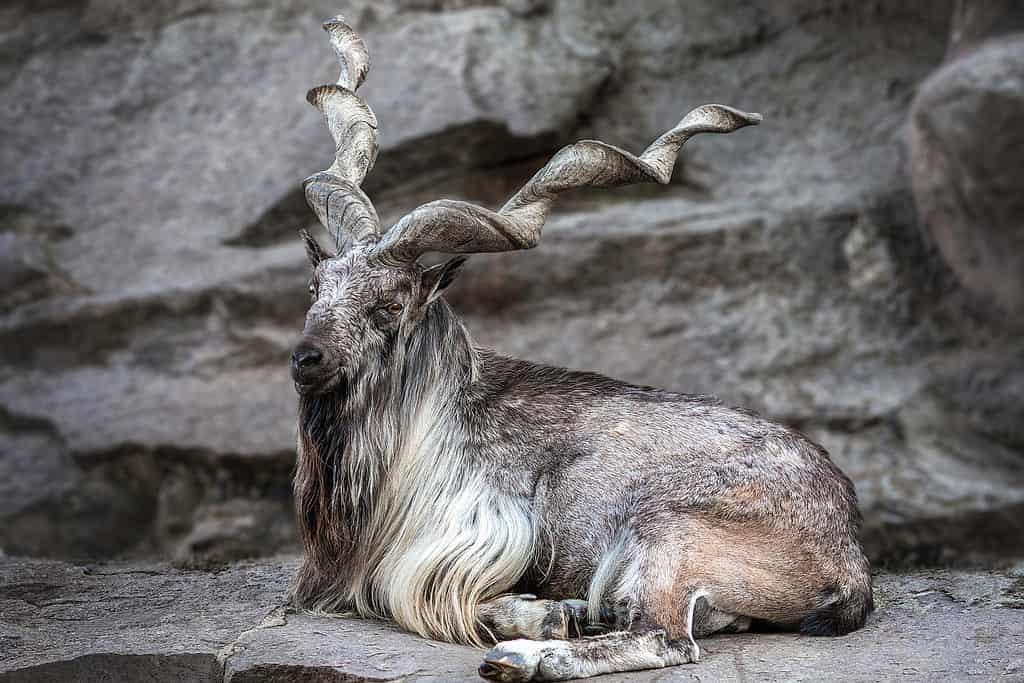Horns are a unique feature that can come in all shapes and sizes. Certain animals have horns that stick straight up, while others curve backward, make a spiral shape, or point outwards. Most common in hoofed mammals, a bone core surrounded by a thick layer of horn keratin, covered in a keratinized epidermis, makes up horns.
Animals often use them to help defend themselves against predators. They also defend themselves from other animals of the same species during times of mating and competition for female partners.
You are reading: Discover 8 Types Of Horned Animals
In this article, we will discover 10 types of horned animals and some fun facts about them. We will also learn about the differences between horns and antlers, compare the different animals in Alaska who have horns, and explore the reasons why the horned viper has horns.

8 Types Of Horned Animals
Bison
Here are some facts about bison and their horns:
– Both male and female bison have short, curved, black horns, which can grow to two feet (0.6 meters) long.
– The horns on bison are actually a hollow cap that grows over a bone-like core.
– The cap of the horn may be accidentally broken off when the bison digs in the mud, but the short core hardens and remains.
– The cap of the horn grows one layer a year, beginning at age 4.
– Bison use their huge heads as snow plows in winter to uncover vegetation to eat.
– In the wild, bison eat mostly grasses, small plants, and twigs of some shrubs.
– Male bison, or bulls, can be 6 feet high at the shoulders and weigh up to 2,000 pounds, while female bison, or cows, are closer to 4 1/2 feet high at the shoulders and 900 pounds.
The horns of bison can also be used for various purposes, such as crafting and decoration. Natural bison horns are available for purchase and can be used to make large powder horns or other items.
Pronghorn
The pronghorn, also known as the pronghorn antelope, is a unique and fascinating animal with distinct characteristics, including its horns:
– Pronghorns are the only surviving members of the family Antilocapridae, making them unique in the animal world.
– They have a body shape similar to a deer, with long legs, a short tail, and a long snout. Their fur can be reddish-brown, tan, or darker brown, and they have white stripes on their necks and additional white markings on the face, stomach, and rump.
– Both males and females have a pair of short horns on the top of their heads. The female’s horns are small, usually only a bump, while the males’ horns are around 10 to 12 inches long.
– Pronghorn horns are forked or branching, with a forward-pointing tine, setting them apart from antelopes and bovids (cattle, sheep, buffalo, etc.).
– The horns are a cross between horns and antlers, with qualities of both. They have an outer sheath of fused, modified hair that covers a permanent, bony core.
– At the front of the horn is a small notch or prong that points forward, giving the animal its name.
– Pronghorns have large eyes and fantastic vision, which helps them spot predators from far away in their flat grassland habitat.
– They are about 4.5 feet long, three feet tall, and weigh between 90 and 150 pounds. Females tend to weigh less than males.
– Pronghorns are the fastest animals in the Western Hemisphere, capable of running at speeds up to 60 miles per hour and sustaining speeds of 30-40 miles per hour for long distances. They can make bounds of up to 20 feet when running.
Mouflon

The mouflon, a small feral sheep belonging to the family Bovidae and order Artiodactyla, is native to the Mediterranean islands of Corsica, Sardinia, and Cyprus. Here are some key facts about the mouflon and its horns:
– Description: The mouflon stands about 70 cm (28 inches) at the shoulder and has a brown coat with white underparts. The male mouflon has a light, saddle-shaped mark on its back and bears large, downward-curving horns with the tips turned outward. The rams have helix-shaped horns that can grow up to 80 cm long.
– Habitat: Mouflons are well-adapted to open terrains above the tree line, and their eyesight is well-developed for scanning a wide arc without turning their heads. Their binocular vision is limited to a relatively small facial arc of 60 percent, allowing them to see depth of field only in this area.
– Behavior: When alarmed, mouflons emit a hiss through their nostrils and may stomp their front feet as a nervous gesture. The warning call of a mouflon can be quiet when the animal is slightly disturbed but becomes much louder as danger threatens. A herd whose leader makes this sound will flee immediately, while the rest of the herd takes defensive action but continues to wait for the leader’s reaction.
Read more : 7 Types Of Aphids
– Horns: The males are horned, and some females are also horned, while others are polled (lack horns). The horns of mature rams are curved almost one full revolution, reaching lengths of up to 85 cm. The position of the horn tip in older rams may restrict their field of view, leading to wear and tear on the horns.
Rhinoceros
Rhinoceroses are large, herbivorous mammals that are characterized by their horn(s) and robust build. Here are some key facts about rhinoceroses:
– There are five or six species of rhinoceros, depending on the classification system. These species include the white rhinoceros, black rhinoceros, Indian rhinoceros, Javan rhinoceros, and Sumatran rhinoceros.
– Rhinoceroses are known for their horn(s), which are not true horns but are composed of keratin, a fibrous protein found in hair. The horns are made of keratin, a chemically complex substance that contains large quantities of sulphur-containing amino acids, calcium carbonate, calcium phosphate, tyrosine, histidine, lysine, and arginine.
– Both male and female rhinoceroses have horns in all five species. The number of horns and their size vary among the different species. For example, the white rhinoceros has two horns, with the larger one in the front and the smaller one usually less than 10 centimeters long.
– Rhino horns are unique in that they grow back when they are damaged or removed. This is because the horns are solely made of keratin, a naturally produced protein that strengthens hair, skin, and nails in humans.
– The primary threat to rhinoceroses is poaching for their horns, which are highly valued in traditional Chinese medicine and as status symbols to display success and wealth. The demand for rhino horn has led to a significant decline in rhinoceros populations, with some subspecies being classified as critically endangered or extinct in the wild.
– Contrary to popular belief, rhino horn is not used as an aphrodisiac in traditional Chinese or Vietnamese medicine. It has been primarily used to treat various illnesses, reduce fevers, stop nosebleeds, and prevent strokes. However, there is no scientific evidence to support the medicinal properties of rhino horn.
Kudu
A kudu is a type of antelope that belongs to the genus Tragelaphus. There are two species of kudu:
– Greater kudu (Tragelaphus strepsiceros): Found in eastern and southern Africa, the greater kudu is a large woodland antelope. Males can grow up to 1.8 meters (about 6 feet) in height and have long, spiral horns with 2-1/2 graceful twists. Females are noticeably smaller than males. They have a bluish-gray, grayish-brown, or rust-colored coat and a fringe under the chin. Greater kudus are sparsely populated in most areas due to habitat decline, deforestation, and poaching.
– Lesser kudu (Tragelaphus imberbis): Found in eastern Africa, the lesser kudu is a smaller and more elusive antelope. It stands about 100 cm (39 inches) high and weighs 92-108 kg (202-238 pounds). Males have smaller horns than their greater kudu counterparts, and both males and females have conspicuous white patches on the upper and lower parts of the neck. Lesser kudus have 11-15 vertical white stripes, a nose chevron, and cheek patches. They inhabit dense thornbush areas below 1,200 meters (3,900 feet) above sea level. Like greater kudus, they are also affected by habitat destruction and hunting.
Kudus are browsers and primarily eat leaves, shoots, and wild watermelons for their liquid content and natural sugars during dry seasons. They are preyed upon by various predators, including lions, leopards, cheetahs, wild dogs, hyenas, crocodiles, and sometimes pythons. Humans also hunt kudus for their meat, hides, and horns, and their habitats are being destroyed for charcoal burning and farming.
African Buffalo
The African buffalo (Syncerus caffer) is a large sub-Saharan African bovine. There are five recognized subspecies, each with distinct characteristics and distributions:
– Syncerus caffer caffer (Cape buffalo): The largest subspecies, found in Southern and East Africa, including the Kruger National Park.
– Syncerus caffer nanus (forest buffalo): The smallest subspecies, common in forest areas of Central and West Africa.
– Syncerus caffer brachyceros: Found in West Africa.
– Syncerus caffer aequinoctialis: Found in the savannas of East Africa.
– Syncerus caffer: The Central African subspecies, also known as the Central African buffalo.
The African buffalo is more closely related to other buffalo species than it is to other bovids, such as American bison or domestic cattle. Its closest living relative is the Asian water buffalo.
African buffaloes are large, heavy, and stocky animals. They have a shoulder height of up to 1.5 meters and can weigh up to 750 kilograms. Both males and females have heavy, ridged horns that grow straight out from the head or curve downward and then up.
The African buffalo is one of the most successful grazers in Africa, living in various habitats such as savannas, swamps, floodplains, mopane grasslands, and forests of the major mountains of Africa. They prefer a habitat with dense cover, such as reeds and thickets, but can also be found in open woodlands. These buffaloes require water daily and depend on perennial sources of water.
African buffaloes are considered one of the “big five” animals, along with leopards, rhinoceroses, elephants, and lions, due to their size and dangerous nature. They are known for their grumpy and unpredictable temperament and can run up to 37 miles per hour. Because of these characteristics, they are considered prize trophies by big game hunters.
The diet of African buffaloes consists mainly of grass, which forms the bulk of their food. They are grazing ruminants and spend a large proportion of their time feeding and extracting nutrients from their food. They prefer grasses with a higher leaf-to-stem ratio, such as those from the genus Themeda.
Read more : Discover The 4 Types Of Mambas
African buffaloes frequently come into conflict with humans, as they are considered crop pests and dangerous animals due to their size, aggressive nature, and formidable horns. They may break fences, raid cultivated crops, and even spread bovine diseases to livestock. In the past, they suffered a dramatic population decline during the great rinderpest epidemic of the 1890s.
Markhor

Markhor is a large Capra species native to South Asia and Central Asia, mainly within Pakistan, the Karakoram range, parts of Afghanistan, and the Himalayas. Here are some key facts about the markhor:
Appearance:
– Markhor stand 65 to 115 centimeters (26 to 45 in) at the shoulder, are 132 to 186 centimeters (52 to 73 in) long and weigh from 32 to 110 kilograms (71 to 243 lb).
– They have the highest maximum shoulder height among the species in the genus Capra, but are surpassed in length and weight by the Siberian ibex.
– The coat is of a grizzled, light brown to black color, and is smooth and short in summer, while growing longer and thicker in winter. The fur of the lower legs is black and white.
– Both sexes have tightly curled, corkscrew-like horns, which close together at the head but spread upwards toward the tips. The horns usually grow up to 5 feet long in mature males.
Habitat and Behavior:
– Markhor are adapted to mountainous terrain, and can be found between 600 and 3,600 m (2,000 and 11,800 ft) in elevation. They typically inhabit scrub forests made up primarily of oaks (Quercus ilex), pines (Pinus gerardiana), and junipers (Juniperus macropoda).
– They are diurnal, and are mainly active in the early morning and late afternoon. Their diets shift seasonally: in the spring and summer periods, they graze, but turn to browsing in winter, sometimes standing on their hind legs to reach high branches.
– Markhor live in flocks that usually consist of nine animals. These flocks are composed of adult females and their young. Adult males are largely solitary. Adult females and kids comprise most of the markhor population.
Conservation Status:
– The markhor is listed on the IUCN Red List as Near Threatened since 2015.
– In India, the markhor is a fully protected (Schedule I) species under Jammu and Kashmir’s Wildlife (Protection) Act of 1978.
– Markhors are poached for their meat and their horns that are believed to have medicinal qualities. They’re also threatened by habitat loss and competition for forgeable lands by domestic livestock.
Jackson’s Chameleon

Jackson’s chameleon, also known as Jackson’s horned chameleon or three-horned chameleon, is a fascinating species native to East Africa. Here are some key facts about Jackson’s chameleon:
Appearance:
– Adult males reach a total length (including tail) of up to 38 cm (15 in), while females typically grow up to 25 cm (10 in).
– Males have three brown horns: one on the nose (the rostral horn) and one above each superior orbital ridge above the eyes (preocular horns).
– Females generally have no horns, or they may have traces of the rostral horn.
– The chameleon has a saw-tooth-shaped dorsal ridge and no gular crest.
Habitat:
– Jackson’s chameleons are native to woodlands and forests at altitudes of 1,600 to 2,440 m (5,250 to 8,010 ft) in south-central Kenya and northern Tanzania.
– They are also introduced to Hawaii, Florida, and California.
Behavior:
– These chameleons are sometimes called three-horned chameleons because males use their horns to defend their territory.
– They are primarily solitary creatures that spend most of their time in trees.
– Chameleons move with a distinctive slow rocking motion.
Diet:
– Jackson’s chameleons primarily feed on small insects, but they also prey on centipedes, isopods, and millipedes.
Lifespan:
– In captivity, Jackson’s chameleons can live for 5 to 10 years. The lifespan in the wild may vary.
FAQS
1. What is the difference between horns and antlers?
Horns and antlers are often used interchangeably, but they refer to quite different structures. Antlers are a pair of bony, branched structures that protrude from the frontals of deer and related species. They are shed and regrown yearly and are found only on males. Horns, on the other hand, are found in males of all species of Bovidae, and females often bear them too. Horns are composed of a bony core covered with a sheath of keratin. Unlike antlers, horns are never branched, but they do vary from species to species in shape and size.
2. What animals have horns?
Horns are found on members of the family Bovidae, which includes animals such as cattle, bison, antelopes, sheep, goat, ibexes, and muskoxen. Other animals, like rhinos, giraffes, pronghorns, and even deer, have horn-like structures.
3. What is the purpose of horns?
Animals have a variety of uses for horns, including defending themselves from predators and fighting members of their own species for territory, dominance, or mating priority. Horns are usually present only in males, but in some species, females too may possess horns.
4. What are some examples of animals with horns?
There are many animals with horns, including:
– Bovidae family: cattle, bison, antelopes, sheep, goat, ibexes, and muskoxen
– Rhinoceros
– Giraffe
– Pronghorn
– Deer
– Jackson’s chameleon
– Markhor
– Mouflon
– Kudu
– African buffalo
– And many more
5. Are horns and antlers used for the same purposes?
Similar to antlers, horns are often used by males in fights and displays during the breeding season. These fights often include clashes that determine body strength. In general (but with many exceptions), horns are present in both sexes of larger species but absent in females of smaller species. This is probably because larger species are more likely to fight whereas smaller species tend to run and/or hide.
6. Are horns and antlers ever used for anything other than fighting?
Yes, horns and antlers can also be used for display purposes, serving as a visual demonstration of an individual’s health and condition. An animal may also use its horns to root in the earth.
7. Are horns ever shed and regrown?
No, horns are never shed and continue to grow throughout an animal’s life. Antlers, on the other hand, are shed and regrown yearly.
8. Why are some animals with horns endangered?
Some animals with horns, such as rhinoceroses, are endangered due to poaching for their horns, which are highly valued in traditional Chinese medicine and as status symbols to display success and wealth. Other animals with horns, such as African buffaloes, may come into conflict with humans, as they are considered crop pests and dangerous animals due to their size, aggressive nature, and formidable horns.
Source: https://petstutorial.com
Category: Animals










